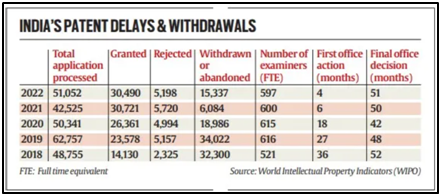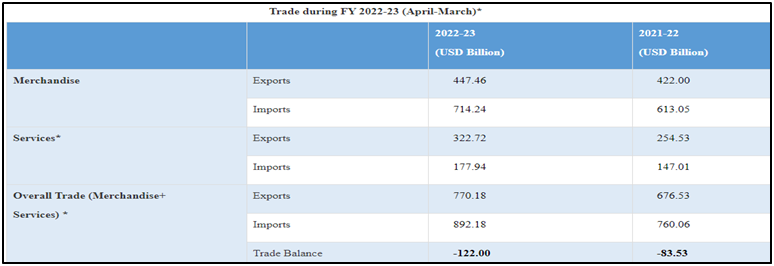Editorials & Articles : 27 May 2024
Patent Process in India

What’s in Today’s Article?
- Background
- About Patent (Meaning, Indian Patent Act, Key Features of Draft Patent Rules, 2023)
- India’s Patent Delays & Withdrawals (Numbers, Causes, etc.)
- Recent Rise in Patent Filing
Background:
- In 2018, the Indian Patent Office had rejected the request of the Proctor and Gamble (P&G) for its patent application.
- The Indian Patent Office is an agency under the Department for Promotion of Industry and Internal Trade which administers the Indian law of Patents, Designs and Trade Marks.
- The P&G challenged the Patent Office’s ruling in the Delhi High Court. The High Court reprimanded the Patent Office saying that the manner of dealing with the application filed by the American multinational company was “extremely arbitrary and whimsical”.
What is a Patent?
- A patent is the granting of a property right by a sovereign authority to an inventor.
- This grant provides the inventor exclusive rights to the patented process, design, or invention for a designated period in exchange for a comprehensive disclosure of the invention.
- Government agencies typically handle and approve applications for patents.
- The Office of the Controller General of Patents, Designs and Trade Marks (CGPDTM), also known as India Patent Office, grants patent so that any invention can be freely commercialised or utilised without any fear of infringement.
- The head patent office is located in Kolkata, West Bengal.
- The Indian Patent Office grants patents which are governed by the Indian Patents Act, 1970.
Indian Patents Act, 1970:
- The Patents Act 1970, along with the Patents Rules, 1972, came into force in April 1972, replacing the Indian Patents and Designs Act, 1911.
- The Patents Act was largely based on the recommendations of the Ayyangar Committee Report headed by Justice N. Rajagopala Ayyangar.
- Later, India became signatory to many international arrangements with an objective of strengthening its patent law and coming in league with the modern world.
- One of the significant steps towards achieving this objective was becoming the member of the Trade Related Intellectual Property Rights (TRIPS) system.
- Significantly, India also became signatory of the Paris Convention and the Patent Cooperation Treaty in 1998 and thereafter signed the Budapest Treaty in 2001.
- Being a signatory to TRIPS, India was under a contractual obligation to amend its Patents Act to comply with its provisions.
- Subsequent amendments were made to the Indian Patents Act, 1970 by the introduction of the Patents (Amendment) Act, 1999, the Patents (Amendment) Act, 2002, the Patent (Amendment) Act, 2005, and Patents (Amendment) Rules, 2006 and the Patents (Amendment) Rules, 2021.
Draft Patents (Amendment) Rules, 2023:
- In August 2023, the Ministry of Commerce and Industry proposed and published Draft Patent (Amendment) Rules, 2023 (the “draft rules”) invited objections and suggestions from all stakeholders within a timeline of 30 days from the date of the publication of the draft Rules.
- Key Highlights of the Draft Rules:
- Pre-Grant Opposition
- Controller can decide a maintainability of the representation and dismiss a pre-grant opposition if found to be frivolous.
- At present, Controller cannot dismiss the representation without offering a chance of hearing to Opponent.
- Time period for applicant to reply to notice has been reduced from 3 months to 2 months.
- Also, Controller has to issue a decision ordinarily within 3 months from the completion of the proceedings.
- Currently, there is no such in which the Controller has to issue a decision.
- Reduced timeline for filing Request for Examination
- As per the draft Rules, the timeline for filing the RFE is now proposed to be reduced to 31 months, which currently is 48 months from the priority date or filing date, whichever is earlier.
- Statement and undertaking regarding foreign applications
- Applicant shall keep the Controller informed of the details in respect of applications filed in any country within two months from the date of issuance of first statement of objections.
- Earlier the duration was six months.
- Annual Working Report
- The draft Rules propose that the Annual Working Report is to be filed in respect of every period of three financial years (currently this is to be filed for every financial year).
- Pre-Grant Opposition
India’s Patent Delays & Withdrawals:
- In 2018, the anti-corruption branch of the Central Bureau of Investigation (CBI) booked SP Subramaniyan, Deputy Controller and branch head in the office of Controller-General of Patents, Designs and Trademarks for demanding a bribe of Rs 10 lakh for releasing a patent.
- The patent applicant in this case had first applied for the patent in 2010 and was allegedly made to wait for five years to get a patent.
- In March 2023, the Delhi High Court pulled up the patent office for passing “mechanical, cut-paste order” while rejecting Blackberry Ltd.’s invention application.
- The Court said that the patent office “must bear in mind that the question of grant and rejection of a patent is a serious matter”.
Impact of Delays & Withdrawals:
- Arbitrary refusals and procedural inconsistencies have marred the track record of India’s patent office.
- It has pushed the share of patent applications withdrawn in India to one of the highest in the world.
- This is at a time when countries such as the US, Japan, South Korea and China are using their patent processing systems to foster scientific research and technological innovation.
- Government officials contend that they have begun addressing these issues and started conducting open house sessions to address grievances, which have improved the process of granting patents over the last 12 months.
Rise in Patent Filing in Recent Times:
- India reported a sharp 44.6% growth in international patent filing in 2023 compared to 2022, as per the World Intellectual Property Organization (WIPO).
- WIPO ranked India third in terms of trademark registrations in force in 2022 at nearly 2.9 million, after China (42.7 million) and the US (3.1 million).
- The Patent Office has granted about 1 lakh patents for the year 2023-24. Everyday about 250 patents are issued and the patent office receives patent applications every six minutes online.
Europe’s AI convention

Why in news?
- Recently, the Council of Europe (COE) adopted the Framework Convention on Artificial Intelligence and Human Rights, Democracy, and the Rule of Law, known as the ‘AI convention’
What’s in today’s article?
- The Council of Europe (COE)
- Framework Convention
- AI Convention
The Council of Europe (COE)
- About
- The Council of Europe (CoE) is an international political organization that was founded in 1949 to protect human rights, democracy, and the rule of law.
- It is the oldest intergovernmental organization in post-World War II Europe and has the most member states, which cooperate voluntarily.
- Headquarter
- The CoE is based in Strasbourg, France and has close ties with the European Union.
- Member
- It has 46 members including the Holy See, Japan, and the U.S., plus countries of the EU bloc and others.
- CoE’s areas of concern
- It addresses issues of common concern to its members, including human rights, crime prevention, drug abuse, environmental protection, bioethical issues, and migration.
Framework convention
- About
- A framework convention is a legally binding treaty that outlines broad commitments and objectives, establishing mechanisms to achieve them.
- Specific targets are left to be determined by subsequent agreements.
- Protocols
- Agreements negotiated under a framework convention are called protocols.
- E.g., the Convention on Biological Diversity is a framework convention, while the Cartagena Protocol on Biosafety addresses living modified organisms under it.
- Similarly, a future ‘Protocol on AI Risk’ could be established under Europe’s AI convention.
- Significance of the Framework Convention Approach
- This approach provides flexibility while encoding core principles and processes to achieve objectives.
- Parties to the convention can decide how to meet these objectives based on their capacities and priorities.
AI Convention
- About
- This agreement is a comprehensive convention covering AI governance and links to human rights, democracy, and the responsible use of AI.
- It will be opened for signature in Vilnius, in Lithuania, on September 5.
- Aims and Definition
- The AI convention ensures that activities involving artificial intelligence systems comply with human rights, democracy, and the rule of law.
- It describes an AI system as a machine-based system that uses input to generate outputs like predictions, content, recommendations, or decisions that can influence both physical and virtual environments.
- Hence, the definition of AI in the convention aligns with the EU AI Act and the OECD’s definition.
- Scope of the AI Convention
- Coverage: The convention applies to all activities within the lifecycle of AI systems that could impact human rights, democracy, and rule of law.
- Public and Private Sector Responsibilities
- Public Authorities: The convention is applicable to AI activities conducted by public authorities or private entities acting on their behalf.
- Private Actors: Risks and impacts from AI activities by private entities not covered by public authorities must be addressed in alignment with the convention’s objectives and purpose.
- Exemptions for National Interests
- Articles 3.2, 3.3, and 3.4 of the convention provide broad exemptions for national security interests, research, development and testing, and national defense.
- Consequently, military applications of AI are excluded from the convention.
- Inclusion of Private Sector
- The inclusion of the private sector in the convention’s scope was contentious, leading to a compromise.
- Article 3(b) provides flexibility for parties to address private sector activities without completely exempting them.
- Protection of Core Values
- Human Rights (Article 4): The convention mandates the protection of human rights.
- Democratic Processes and Rule of Law (Article 5): It emphasizes maintaining the integrity of democratic processes and respect for the rule of law.
- Although disinformation and deep fakes are not specifically mentioned, parties are expected to take measures against them under Article 5.
- Flexibility for Enhanced Commitments
- Article 22 allows parties to exceed the commitments and obligations specified in the convention, encouraging further proactive measures.
AI convention – Significance
- No New AI-Specific Rights
- The AI convention does not introduce new human rights specific to AI.
- Instead, it emphasizes that existing human and fundamental rights, protected by international and national laws, must remain safeguarded during the application of AI systems.
- Government Obligations
- The convention primarily directs its obligations towards governments, which are expected to implement effective remedies (Article 14) and procedural safeguards (Article 15).
- Protection of Core Values
- The convention adopts a comprehensive approach to mitigate risks from AI applications regarding human rights, democracy, and the rule of law.
- This approach recognizes the dynamic nature of AI technology and the challenges it presents.
- Balance Between Innovation and Risk
- Despite potential challenges and debates, particularly around the European notion of the rule of law, the convention is considered timely.
- It strikes a crucial balance between fostering innovation in AI and addressing risks to human rights.
- Challenges
- Implementing the convention poses challenges, especially as AI regulation frameworks are still evolving and technology advances rapidly, often outpacing existing laws and policies.
AI Convention – Impact
- Regional Influence
- The AI convention could inspire similar conventions at the regional level in other parts of the world, promoting global standards in AI governance.
- Indirect Effect on the U.S.
- As the U.S. is a member of the Council of Europe (COE), the AI convention might indirectly influence AI governance in the U.S., which is significant given its status as a hub for AI innovation.
- European Values and Norms
- A potential downside is that the AI convention might be seen as heavily influenced by European values and norms in technology governance.
- This could lead to perceptions of bias.
Status of spice exports

Why in news?
- Last month, Hong Kong and Singapore recalled certain spice mix products from MDH and Everest Group due to higher than prescribed levels of the sterilizing agent Ethylene Oxide (ETO).
- In response, Indian authorities have initiated several measures to ensure that Indian spices comply with the food safety standards of importing countries.
What’s in today’s article?
- Size of Indian exports
- Recent incidents of contamination
- Steps taken by India
Size of Indian exports
- About
- A quick export estimate data available with the Spices Board India shows that India enjoys a significant share in the global market for spices and spice products.
- Statistics
- In 2023-2024, India exported spices worth $4.4 billion (nearly 14 lakh tonnes), which is 12.3% higher than the financial year 2022-2023.
- Products exported
- Chilli, spice oils and oleoresins, curry powder and paste, cumin, mint products, cardamom and pepper are some of the largest exported spices and spice products in the financial year 2022-2023.
- In terms of production, garlic, ginger and chilli were the top three spices produced in FY23.
- Major export destination
- India exported spices and spice products to 180 destinations worldwide.
- China, Bangladesh, west Asian countries and the U.S. are important markets for Indian spices.
Recent incidents of contamination
- About
- In May 2024, some spice mixes from the Indian brands Everest and MDH were found to contain ethylene oxide, a cancer-causing chemical, and banned in Singapore and Hong Kong.
- The products were recalled and banned in these markets.
- Source of contamination
- India does not use Ethylene Oxide (ETO) as a pesticide but as a sterilizing agent to reduce microbial load in finished spice products.
- Spices and other agricultural products are often contaminated in mandies (auction yards) due to contact with humans, birds, reptiles, and insects.
- Large factories receiving materials from these mandies are left with high microbial levels, necessitating the use of ETO sterilization.
- However, contamination can be reduced early through value addition processes.
- Consumers are encouraged to focus on the quality of products, not just their prices, to ensure safer and healthier food choices.
Impact of recall
- Recall, Not a Ban
- An official from the Federation of Indian Spice Stakeholders clarified that Singapore and Hong Kong recalled, but did not ban, Indian spice products.
- Exports to these countries have resumed, so a significant impact is not expected in the coming months.
- India’s share in spice production
- India contributes about 70% of global spice production.
- Hence, such incidents of contamination will affect India’s image as a spice producer.
- Varied Standards
- Countries have different standards for Ethylene Oxide (ETO) and maximum residue levels (MRL).
- While ETO is permitted by the U.S., the EU seeks steaming as the method for sterilisation.
- But while the cost of using ETO as a sterilising agent is Rs 5 per kg, for steaming it is Rs 20-25 a kg.
- The Indian spice industry is urging the government to negotiate with the EU to relax these stringent norms to enhance Indian spice exports to European markets.
- Also, the Indian government should lay down achievable guidelines and tell the buying countries about it.
- Countries have different standards for Ethylene Oxide (ETO) and maximum residue levels (MRL).
Steps taken by the India
- Issuance of Protocols
- Following the recalls by Hong Kong and Singapore, the Spices Board of India issued a detailed protocol to all manufacturing exporters to prevent ETO contamination.
- Mandatory Testing
- The Board initiated mandatory testing of spice consignments destined for Singapore and Hong Kong specifically for ETO levels.
- International Standards
- The Spices Board has engaged with the international food standards body to address the need for uniform ETO usage limits, as these standards vary across different countries.
- Consumer Awareness
- There is an ongoing effort to educate consumers about the importance of quality over price.
- By encouraging consumers to focus on the quality of products, there is a push towards higher standards in the spice industry.
- Industry-Government Collaboration
- The spice industry and government are working together to ensure that Indian spices comply with the varying standards of different countries, addressing issues specific to each market to prevent future recalls.
India’s Foreign Trade with its Major Trading Partners

Why in News?
- According to the latest data of the Ministry of Commerce & India, India has recorded a trade deficit (difference between imports and exports) with 9 of its top 10 trading partners in fiscal year (FY) 2023-24.
What’s in Today’s Article?
- India’s Foreign Trade
- Latest Trends of India’s Foreign Trade
- India’s Trade Deficit with its Major Trading Partners
India’s Foreign Trade:
- Overview:
- Foreign trade in India includes all (merchandise + services) imports and exports to and from India and it accounted for 48.8% of India’s GDP in 2018.
- At the level of the Central Government, trade is administered by the Ministry of Commerce and Industry.
- In 2022, India was the number 15 in total exports, the number 8 in total imports.
- According to the Commerce Ministry data, China was India’s top trading partner from 2013-14 till 2017-18 and also in 2020-21.
- Before China, the UAE was the country’s largest trading partner. The US was the largest partner in 2021-22 and 2022-23.
- Exports (merchandise):
- The top exports of India are Refined Petroleum ($86.2B), Diamonds ($25.9B), Packaged Medicaments ($19.5B), Jewellery ($12.6B), and Rice ($11.1B).
- It exports mostly to the United States ($82.9B), United Arab Emirates ($31.6B), Netherlands ($17.6B), China ($15.3B), and Bangladesh ($13.8B).
- In 2022, India was the world’s biggest exporter of Diamonds ($25.9B), Rice ($11.1B), etc.
- Imports (merchandise):
- The top imports of India are Crude Petroleum ($170B), Coal Briquettes ($58.7B), Gold ($35.8B), Petroleum Gas ($32B), and Diamonds ($26.1B).
- It imports mostly from China ($110B), UAE ($51B) and the US ($48.5B), Saudi Arabia ($46.2B), and Russia ($40.4B).
- In 2022, India was the world’s biggest importer of Coal Briquettes ($58.7B), Diamonds ($26.1B), Palm Oil ($11.1B), Mixed Mineral or Chemical Fertilizers ($7.88B), and Nitrogenous Fertilizers ($7.37B).
Latest Trends of India’s Foreign Trade:
- As per the data from the economic think tank GTRI, China has overtaken the US as India’s largest trading partner, with a total two-way commerce of $118.4 billion, in the FY 2023-24.
- India’s exports to China rose by 8.7% to $16.67 billion, while imports increased by 3.24% to $101.7 billion.
- On the other hand, exports to the US dipped slightly to $77.5 billion, and imports decreased by about 20% to $40.8 billion (the two-way commerce stood at $118.3 billion).
- The UAE with USD 83.6 billion, was the third largest trading partner of India. It was followed by Russia ($65.7 billion), Saudi Arabia ($43.4 billion), and Singapore ($35.6 billion).
India’s Trade Deficit with its Major Trading Partners:
- Latest trends:
- India’s trade deficit with China rose to $85 billion, Russia to $57.2 billion, Korea to $14.71 billion and Hong Kong to $12.2 billion in 2023-24 against $83.2 billion, $43 billion, $14.57 billion and $8.38 billion in 2022-23.
- India has a trade surplus of $36.74 billion with the U.S. in 2023-24 and America is one of the few countries with which India has a trade surplus along with the U.K., Belgium, Italy, France and Bangladesh.
- India’s total trade deficit in the last fiscal narrowed to $238.3 billion as against $264.9 billion in the previous fiscal.
- What can be drawn from these latest trends?
- Imports are not always bad if a country is importing raw materials or intermediary products to boost manufacturing and exports.
- However, it can cause the country’s currency to depreciate because more foreign currency is needed for imports.
- This depreciation makes imports more expensive, worsening the deficit and increasing external debt.
- This can deplete foreign exchange reserves and signal economic instability to investors, leading to reduced foreign investment.
- What needs to be done to cut the trade deficit? Boosting exports, reducing unnecessary imports, developing domestic industries, and managing currency and debt levels effectively.






